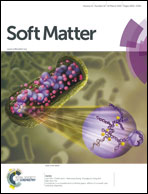Real-space evidence of the equilibrium ordered bicontinuous double diamond structure of a diblock copolymer†
Abstract
The ordered bicontinuous double diamond (OBDD) structure has long been believed to be an unstable ordered network nanostructure, which is relative to the ordered bicontinuous double gyroid (OBDG) structure for diblock copolymers. Using electron tomography, we present the first real-space observation of the thermodynamically stable OBDD structure in a diblock copolymer composed of a stereoregular block, syndiotactic polypropylene-block-polystyrene (sPP-b-PS), in which the sPP tetrapods are interconnected via a bicontinuous network with Pn![[3 with combining macron]](https://www.rsc.org/images/entities/char_0033_0304.gif) m symmetry. The OBDD structure underwent a thermally reversible order–order transition (OOT) to OBDG upon heating, and the transition was accompanied with a slight reduction of domain spacing, as demonstrated both experimentally and theoretically. The thermodynamic stability of the OBDD structure was attributed to the ability of the configurationally regular sPP block to form helical segments, even above its melting point, as the reduction of internal energy associated with the helix formation may effectively compensate the greater packing frustration in OBDD relative to that in the tripods of OBDG.
m symmetry. The OBDD structure underwent a thermally reversible order–order transition (OOT) to OBDG upon heating, and the transition was accompanied with a slight reduction of domain spacing, as demonstrated both experimentally and theoretically. The thermodynamic stability of the OBDD structure was attributed to the ability of the configurationally regular sPP block to form helical segments, even above its melting point, as the reduction of internal energy associated with the helix formation may effectively compensate the greater packing frustration in OBDD relative to that in the tripods of OBDG.


 Please wait while we load your content...
Please wait while we load your content...